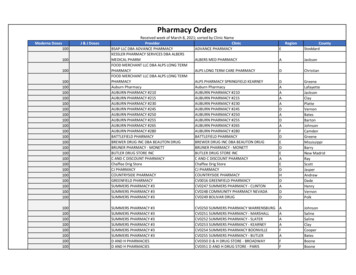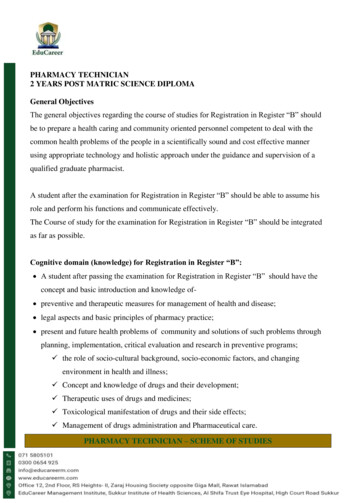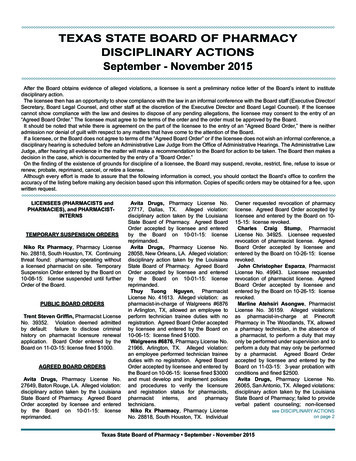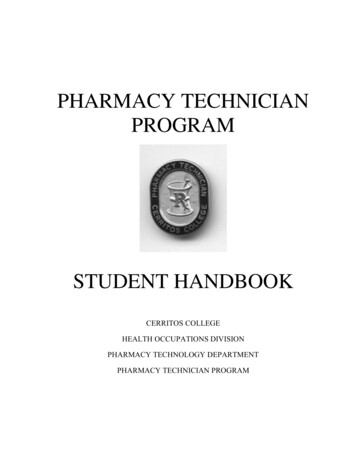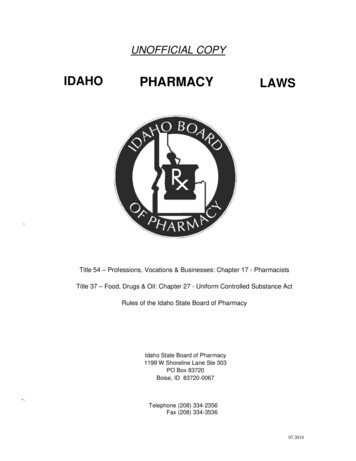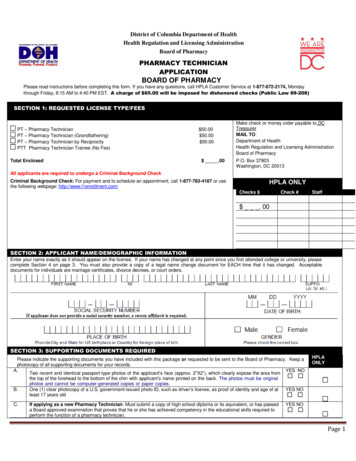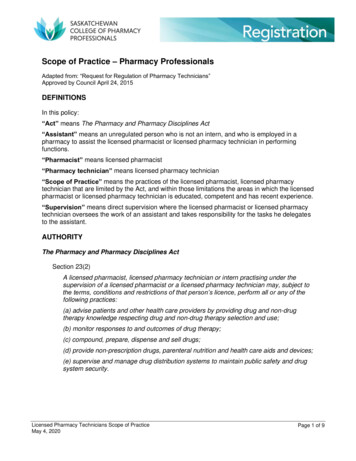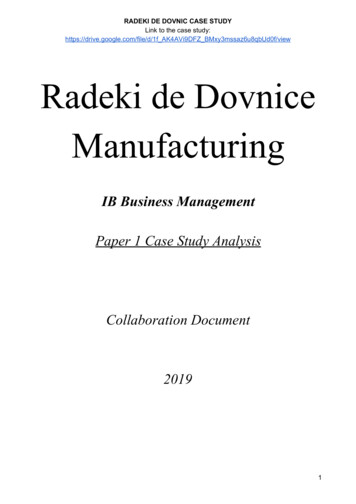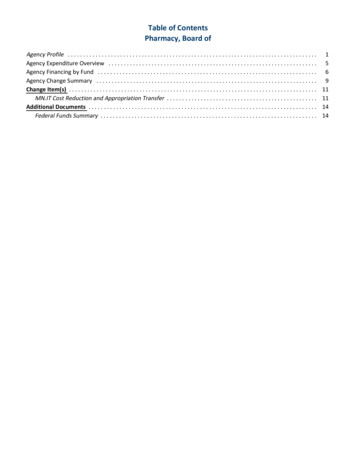
Transcription
Table of ContentsPharmacy, Board ofAgency Profile . . . . . . . . . . . . . . . . . . . . . . . . . . . . . . . . . . . . . . . . . . . . . . . . . . . . . . . . . . . . . . . . . . . . . . . . . . . . . . . . .Agency Expenditure Overview . . . . . . . . . . . . . . . . . . . . . . . . . . . . . . . . . . . . . . . . . . . . . . . . . . . . . . . . . . . . . . . . . . . .Agency Financing by Fund . . . . . . . . . . . . . . . . . . . . . . . . . . . . . . . . . . . . . . . . . . . . . . . . . . . . . . . . . . . . . . . . . . . . . . .Agency Change Summary . . . . . . . . . . . . . . . . . . . . . . . . . . . . . . . . . . . . . . . . . . . . . . . . . . . . . . . . . . . . . . . . . . . . . . . .Change Item(s) . . . . . . . . . . . . . . . . . . . . . . . . . . . . . . . . . . . . . . . . . . . . . . . . . . . . . . . . . . . . . . . . . . . . . . . . . . . . . . . . .MN.IT Cost Reduction and Appropriation Transfer . . . . . . . . . . . . . . . . . . . . . . . . . . . . . . . . . . . . . . . . . . . . . . . . .Additional Documents . . . . . . . . . . . . . . . . . . . . . . . . . . . . . . . . . . . . . . . . . . . . . . . . . . . . . . . . . . . . . . . . . . . . . . . . . .Federal Funds Summary . . . . . . . . . . . . . . . . . . . . . . . . . . . . . . . . . . . . . . . . . . . . . . . . . . . . . . . . . . . . . . . . . . . . . .156911111414
Pharmacy, Board ofAgency Profilemn.gov/boards/pharmacy/AT A GLANCEBoard Members and Staff (As of 7/1/2020) 9 board members (six pharmacists and three public members) appointed by the Governor 23 full time employeesLicenses & Registrations Issued (as of 7/1/2020) 19,749 individuals 3,789 businessesInspections (For FY 2018 and 2019) 589 inspections of licensed facilities, including pharmacies, drug manufacturers and wholesalers, andmedical gas distributorsComplaint & Discipline (For FY 2018 and 2019) 283 new jurisdictional complaints received 309 jurisdictional complaints resolved 49 disciplinary actions takenPrescription Monitoring Program (PMP) (For calendar year 2018) 6.98 million controlled substance prescriptions reported to PMP 25,798 enrolled PMP Users 1.58 million database queriesPURPOSEThe Board’s mission is to preserve and protect the public health, safety, and welfare of Minnesotans by promotingthe safe distribution of pharmaceuticals and the provision of quality pharmacy care.The Board fulfills this mission through examination and licensure of pharmacists, regulation of the practice ofpharmacy, regulation of the manufacturing and distribution of pharmaceuticals, inspection of licensed facilities,investigation of complaints, and the issuance of disciplinary orders and agreements for corrective action. Boardstaff also help educate pharmacists and others about laws, rules and best standards of practice. The Boardprovides information to the public on its Website related to the practice of pharmacy and prescription drugs.The Board also administers several programs, including: The Minnesota Prescription Monitoring Program, theOpiate Product Fee Registration Program, and the Minnesota Insulins Safety Net Program.State of Minnesota12022-23 Biennial BudgetJanuary 2021
BUDGETSource: Budget Planning & Analysis System (BPAS)Source: Consolidated Fund StatementThe Board is mostly funded by licensure fees and, with two recent and temporary exceptions for the OpiateProduct Registration Fee Program and the Insulin Safety Net Program, has received no general fund or healthcareaccess fund dollars. Minnesota Statutes section 214.06, subdivision 1(a) requires the Board to collect fees in theamount sufficient to cover direct and indirect expenditures. Funds are deposited as non-dedicated revenue intothe state government special revenue fund. From this fund, the Board receives a direct appropriation to pay foragency expenses such as salaries, rent, costs associated with disciplinary/contested cases and operatingexpenditures. It also pays statewide indirect costs through an open appropriation.In addition to Board operations, licensure fees fund activities that support other boards and agencies. Some ofthese are: the Administrative Services Unit (inter-board), Health Professionals Services Program (inter-board),Prescription Monitoring Program (Pharmacy Board), Office of the Attorney General for legal services, and theCriminal Background Check Program (inter-board).STRATEGIESThe Board’s primary strategy is to promote adherence to state and federal laws and rules relating to the practiceof pharmacy and the manufacture and distribution of drugs. Another, equally important strategy is to promotethe adoption of cutting-edge standards of practice that go beyond the minimum requirements specified in thestatutes and rules. The Board’s activities can be divided into several areas of focus:Licensing. Licensing is the Board’s “foundation,” on which most activities ultimately rest. The ability to issuelicenses and registrations empowers the Board to inspect facilities, investigate complaints, and take disciplinaryaction when necessary. In addition, the Board is primarily funded by the licensing and registration fees that itcollects. Most of the Board’s staff members are involved in some aspect of the licensing process. Administrativestaff members process applications and work with the National Association of Boards of Pharmacy to make surethat applicants for a pharmacist license have passed the required examinations. Compliance staff membersconduct initial inspections of facilities before they are allowed to be licensed.State of Minnesota22022-23 Biennial BudgetJanuary 2021
Compliance. Activities in this area can be further divided as follows: Inspections. The Board licenses or registers over 2,000 in-state pharmacies, drug wholesalers, drugmanufacturers, medical gas distributors and controlled substance researchers. Each facility is inspected bya Board Surveyor before it can open. Subsequent, unannounced inspections are also periodicallyconducted.Complaint Investigations. The Board investigates every jurisdictional complaint it receives. A BoardSurveyor visits the pharmacy in question, meets with pharmacy staff, reviews the policies and proceduresof the pharmacy, and directs pharmacy staff to make necessary changes to policies and procedures. Forcases involving certain issues, such as alleged physical or mental impairment of a licensee, the Boardrefers the matter to the Attorney General’s Office (AGO) for investigation. The Surveyor or the AGOInvestigator issues a report which is reviewed by the Board’s Complaint Review Panel (CRP). CRP maydismiss the complaint if the allegations aren’t proven or may refer the matter on for discipline.Discipline. If either the CRP or the Board’s Executive Director (ED) determines that the evidencesubstantiates a serious violation of statutes or rules, the matter is turned into a disciplinary case. The EDworks with the AGO to initiate the due process procedures that the Board must follow. The licensee orregistrant is directed to appear before a Committee on Professional Standards, which weighs the availableevidence. In most cases, if the Committee determines that discipline is warranted, it reaches a settlementagreement with the licensee or registrant. Such agreements, which must be approved by the full Board,usually involve the issuance of a disciplinary order which places limitations and conditions on the licenseor registration of the person or business that was investigated.Consultations. The Executive Director, Deputy Director, and Board Surveyors are licensed pharmacistswith, collectively, nearly 200 years of experience working in a variety of pharmacy settings. As such, theiradvice is sought on a daily basis by pharmacists and other licensees and registrants. The ED, DD andSurveyors provide consultations on issues that are often extremely technical and complex. The goal of allconsultations is to promote both adherence to laws and rules and the adoption of cutting-edge standardsof practice and technology that help protect the health, welfare, and safety of citizens.Policy, Regulatory and Legislative Activities. As new standards of practice emerge and new technologies aredeveloped, the Board and its staff work to update guidances, rules, and statutes. Guidances help licensees andregistrants use new technologies and procedures in a way that best promotes the health, welfare, and safety ofcitizens. As new technologies and standards of practice become more broadly accepted, the Board willpromulgate rules, as necessary, to replace the guidances or propose statutory changes. In addition, Board staffvery frequently provide technical assistance to legislators and their staff on a variety of issues concerningpharmacy and drugs. The Board also works on policy issues with other local, state, and federal agencies, includinglocal law enforcement agencies, county attorneys, the state Departments of Human Services and Health, theMinnesota Pollution Control Agency, the Bureau of Criminal Apprehension, the U.S. Drug EnforcementAdministration, and the U.S. Food and Drug Administration.Services for the General Public. Board staff provides direct services to the public. Staff provide information tothe public in response to inquiries concerning the legal requirements and standards for pharmacy practice. Thepublic can use the Board’s online license verification system to verify that individuals and businesses are licensedby the Board and to determine if any disciplinary action has been taken against a licensee or registrant. The Boardprovides free copies of disciplinary orders to the public upon request.Prescription Monitoring Program. The purpose of the Prescription Monitoring Program (PMP) is to promotepublic health, safety, and welfare by detecting abuse or misuse of controlled substances— drugs that have a highpotential for abuse and addiction, such as narcotics and stimulants. The PMP collects information concerningcontrolled substance prescriptions dispensed for people residing in Minnesota. Prescribers, pharmacists, andcertain Medicaid staff can access this data through a secure online system. The PMP is a tool that theseauthorized users can employ in order to detect if a patient is obtaining prescriptions from multiple prescribers andState of Minnesota32022-23 Biennial BudgetJanuary 2021
having them filled by multiple pharmacies. The Board encourages prescribers and pharmacists who identifyindividuals who appear to be engaged in such an activity to refer them for appropriate care – either chemicaldependency treatment or pain management. Law enforcement officials can obtain data from the system as well,but only after obtaining a court-issued search warrant and serving it on the Board.RESULTSType of MeasureName of MeasurePreviousCurrentDatesQuantityPercentage of in-state facility inspectionscompleted annually17.1%19.3%FY 2017FY 2018QualityPercentage of complaints investigated andresolved within 12 months68.1%76.8%FY 2018FY 2019ResultsNumber of individuals who receiveprescriptions from five or more prescribersand have them filled at five or morepharmacies within a three-month period oftime6375567/1/2018 –12/31/20187/1/2019 –12/31/2019Sections of MN Statutes Chapters 151 (https://www.revisor.mn.gov/statutes/?id 151), 152(https://www.revisor.mn.gov/statutes/?id 152) and 214 (https://www.revisor.mn.gov/statutes/?id 214) providethe Board of Pharmacy with legal authority to carry out its duties.State of Minnesota42022-23 Biennial BudgetJanuary 2021
Pharmacy, Board ofAgency Expenditure Overview(Dollars in 2187283Governor'sRecommendationForecast BaseFY22FY23FY22FY23Expenditures by Fund1000 - General1201 - Health Related 1466161616162001 - Other Misc Special Revenue3653653653653652005 - Opiate Epidemic Response12612612612612676767676762000 - Restrict Misc Special Revenue2360 - Health Care Access3000 - 41Biennial ChangeBiennial % ernor's Change from Base130Governor's % Change from Base1Expenditures by ProgramPharmacy ,2945,1414,9215,2064,986Full-Time 0Expenditures by CategoryCompensationOperating ExpensesOther Financial TransactionState of Minnesota52022-23 Biennial BudgetJanuary 2021
Pharmacy, Board ofAgency Financing by Fund(Dollars in 21Governor'sRecommendationForecast BaseFY22FY23FY22FY231000 - GeneralBalance Forward In283Direct Appropriation370Balance Forward Out283Expenditures87Biennial Change in Expenditures283370Biennial % Change in Expenditures(370)(370)(100)(100)Governor's Change from Base0Governor's % Change from BaseFull-Time Equivalents0.441201 - Health Related BoardsBalance Forward InDirect Appropriation1173,164Open AppropriationTransfers InTransfers nce Forward Out4952021173,1054943,1813,833Biennial Change in ExpendituresBiennial % Change in Expenditures2,38471373802Governor's Change from Base130Governor's % Change from BaseFull-Time 000 - Restrict Misc Special RevenueBalance Forward InReceiptsBalance Forward OutExpendituresBiennial Change in ExpendituresBiennial % Change in ExpendituresGovernor's Change from BaseState of Minnesota51(48)(48)177(60)(60)062022-23 Biennial BudgetJanuary 2021
Pharmacy, Board ofAgency Financing by Fund(Dollars in 21Governor'sRecommendationForecast BaseFY22FY23FY22Governor's % Change from BaseFY230Full-Time Equivalents0.040.102001 - Other Misc Special 5365365Biennial Change in Expenditures365365365Biennial % Change in ExpendituresGovernor's Change from Base0Governor's % Change from Base02005 - Opiate Epidemic ResponseDirect 26126Biennial Change in Expenditures126126126Biennial % Change in ExpendituresGovernor's Change from Base0Governor's % Change from Base02360 - Health Care AccessDirect ial Change in Expenditures767676Biennial % Change in ExpendituresGovernor's Change from Base0Governor's % Change from Base03000 - FederalBalance Forward InReceiptsBalance Forward 1109Biennial Change in ExpendituresState of Minnesota6227111220111220(643)(643)2022-23 Biennial BudgetJanuary 2021
Pharmacy, Board ofAgency Financing by Fund(Dollars in 21Biennial % Change in Expenditures259Governor's Change from BaseGovernor'sRecommendationForecast BaseFY22FY23(75)FY22FY23(75)0Governor's % Change from BaseFull-Time EquivalentsState of Minnesota0.331.050.3380.252022-23 Biennial BudgetJanuary 2021
Pharmacy, Board ofAgency Change Summary(Dollars in 4038,806FY2021 Appropriations126126126252Forecast Base126126126252Total Governor's Recommendations126126126252FY2021 Appropriations767676152Forecast Base767676152Total Governor's Recommendations767676152Planned Spending66161632Forecast Base66161632Total Governor's Recommendations66161632Planned Spending365365365730Forecast Base365365365730Total Governor's Recommendations365365365730Planned Spending542220220Forecast Base542220220Total Governor's Recommendations542220220DirectFund: 1201 - Health Related BoardsFY2021 AppropriationsBase AdjustmentsCurrent Law Base ChangeForecast Base4,341Change ItemsMN.IT Cost Reduction and Appropriation TransferTotal Governor's RecommendationsFund: 2005 - Opiate Epidemic ResponseFund: 2360 - Health Care AccessDedicatedFund: 2000 - Restrict Misc Special RevenueFund: 2001 - Other Misc Special RevenueFund: 3000 - FederalRevenue Change SummaryDedicatedState of Minnesota92022-23 Biennial BudgetJanuary 2021
Pharmacy, Board ofAgency Change Summary(Dollars in Thousands)Biennium2022-23FY21FY22FY23Forecast Revenues66161632Total Governor's Recommendations66161632Forecast Revenues365365365730Total Governor's Recommendations365365365730Forecast Revenues542220220Total Governor's Recommendations542220220Forecast Revenues3,3273,3273,3276,654Total Governor's Recommendations3,3273,3273,3276,654Forecast Revenues13,67513,67513,67527,350Total Governor's Recommendations13,67513,67513,67527,350Fund: 2000 - Restrict Misc Special RevenueFund: 2001 - Other Misc Special RevenueFund: 3000 - FederalNon-DedicatedFund: 1201 - Health Related BoardsFund: 2005 - Opiate Epidemic ResponseState of Minnesota102022-23 Biennial BudgetJanuary 2021
Board of PharmacyFY 2022-23 Biennial Budget Change ItemChange Item Title: MN.IT Cost Reduction and Appropriation TransferFiscal Impact ( 000s)ASU (Transfer from BELTSS to Dentistry)General Fund*ExpendituresRevenuesState Government Special RevenueExpendituresRevenuesPharmacy, Board ofState Government Special RevenueExpendituresRevenuesDentistry, Board ofState Government Special RevenueExpendituresRevenuesChiropractic Examiners, Board ofState Government Special RevenueExpendituresRevenuesOptometry, Board ofState Government Special RevenueExpendituresRevenuesBELTSSState Government Special RevenueExpendituresRevenuesSocial Work, Board ofState Government Special RevenueExpendituresRevenuesMarriage and Family Therapy, Board ofState Government Special RevenueExpendituresRevenuesPodiatric Medicine, Board ofState Government Special RevenueExpendituresRevenuesVeterinary Medicine, Board ofState Government Special RevenueExpendituresState of MinnesotaFY 2022FY 2023FY 2024FY 0050050022022022022015015015015010101010112022-23 Biennial BudgetJanuary 2021
Fiscal Impact ( 000s)RevenuesDietetics and Nutrition Practice, Board ofState Government Special RevenueExpendituresRevenuesPhysical Therapy, Board ofState Government Special RevenueExpendituresRevenuesBehavioral Health and Therapy, Board ofState Government Special RevenueExpendituresRevenuesNet Fiscal Impact (Expenditures – Revenues)FTEsFY 20220FY 20230FY 20240FY 25)350(325)0000*There is no General Fund impact to the health licensing boards listed in Fiscal Impact chart.Recommendation:The Governor recommends the Health-Related Licensing Boards’ IT expense reorganization and reduction. TheAdministrative Services Unit (ASU) is authorized by Minn. Stat. 214.107 and serves as an agent to the HealthRelated Licensing Boards. ASU is seeking a 647,000 reduction in its FY 2022 and FY 2023 appropriation and acorresponding 322,000 increase in appropriation for twelve (12) Health-Related Licensing Boards (Table 1) for anet reduction of 325,000. This appropriation decrease is the result of the Health-Related Licensing Boards’restructuring and reduction of IT-related costs. The appropriation increases for the twelve (12) Health-RelatedLicensing Boards will fund IT expenses previously paid by ASU.Rationale/Background:Since the creation of MN.IT Services in 2012, funds to pay all technology-related costs of the Health-RelatedLicensing Boards have been appropriated to ASU as the boards’ agent. MN.IT staff were assigned to the boardsand costs consolidated and paid by ASU. As part of its IT restructuring efforts, the Health-Related Licensing Boardsworked with MN.IT to reduce the number of MN.IT staff directly assigned to the boards and move to direct-billing.This requires a transfer of the appropriation for IT-related costs from ASU to certain boards.The Health-Related Licensing Boards are fee-supported agencies. The Boards are required by Minnesota Statutesto collect enough revenue to cover all direct-appropriated and indirect costs. The Health-Related LicensingBoards’ collected fee revenues are deposited into the State Government Special Revenue fund to cover theboards’ IT-related costs. This reduction does not impact the State’s General Fund.Proposal:The Health-Related Licensing Boards’ IT reorganization includes reduction of FTEs including software developerposition and IT manager position. Database support and project management services will now be paid as neededby contract instead of by assigned FTE. These staffing changes result in a 325,000 annual reduction in ASU’sappropriation. The remaining IT-related costs have been itemized and allocated to the boards and relatedprograms for payment as direct expenditures beginning in FY 2022. The itemization and allocation results in a 647,000 reduction in the ASU appropriation and an appropriation increase for twelve (12) boards to cover ITrelated costs which will now be direct-billed.State of Minnesota122022-23 Biennial BudgetJanuary 2021
This proposal is impacted by the transfer of the ASU appropriation from the Board of Executives for Long TermServices and Supports (BELTSS) to the Board of Dentistry beginning in FY 2022, which was submitted as a separatechange item. The ASU appropriation for MN.IT will be reduced by 647,000 (from 1,214,000 to 567,000) whenit transfers from BELTSS to Dentistry.Impact on Children and Families:The Health-Related Licensing Boards work to promote public protection, including the protection of thechildren and families of the State of Minnesota. This change will not impact the boards’ ability to continue toprotect the people of Minnesota.Equity and Inclusion:The Health-Related Licensing Boards do not discriminate on the basis of race, ethnicity, gender, sexualorientation, or disability. This change will not impact the boards’ ability to provide services for all people of theState of Minnesota, without discrimination.State of Minnesota132022-23 Biennial BudgetJanuary 2021
Federal Funds SummaryPharmacy, Board of(Dollars in Thousands)Federal Agency andCFDA #U.S Department ofJustice Office ofJustice Programs 16.754US Department ofJustice, Office ofJustice Programs 16.754MN Department ofHealth - 93.136MN Department ofHuman Services 93.243Federal Award Name and Brief Purpose2018 Harold Rogers Prescription DrugMonitoring Program. Purpose: Furtherenhancement of the MN PrescriptionMonitoring Program.2016-Harold Rogers Prescription DrugMonitoring Program Purpose: To enhance theMN Prescription Monitoring Program (PMP).Injury Prevention and Control Research andState and County Based Programs Purpose:Increase registration and use of PMP throughintegrating account registration into the healthprofessional’s licensing process. Funds to be, inpart, awarded to health licensing boards.Substance Abuse and Mental Health ServiceProject of Regular and National SignificancePurpose: Plan and carryout the delivery of fourregional information/educations sessions forhealth care providers with permissible use ofPMP data.NewGrantFY 2020ActualsFY 2021BudgetFY 2022BaseRequiredStateMatch orMOE?FY 2023BaseNo 73 457 220 -nono 100 - - -nono 121 - - -nono 26 85 - -no 320 542 220 -Federal Fund – Agency TotalFTEs0.250.25Narrative2018 Harold Rogers Prescription Drug Monitoring Program:Funds were awarded to educate end users about the database and the updated functionalities; to ensure continued and accurate use of the system; createand distribute an educational tool; deploy analytics, visualization, and clinical intervention tools for system end users; expand the system’s reportgeneration capabilities; travel to mandatory meetings as required by the grant conditions; and fund up to .38 FTE for grant management during the firstyear of the grant.The creation and distribution of educational tools and resources is expected to cease within 12 months of the implementation of the updated systemfunctionalities. There is a long-term commitment to continue to provide the enhanced version of the system, including the analytics, visualization andadditional clinical tools and to expand the report generation capabilities of the system.2016 Harold Rogers Prescription Drug Monitoring Program:Funds were awarded to enhance the functioning of the data collection and analysis system; enhance educational and training programs; facilitateinformation sharing among states; enhance the capacity to provide unsolicited reports to health care professionals regarding their patients; and travel asrequired by the grant conditions.Injury Prevention and Control Research and State and County Based Programs:Funds were provided by the MN Department of Health specifically to support the development of a solution to integrate the PMP registration process intothe health licensing board’s initial licensee application process, and to measure the effectiveness of their solutions. It is anticipated that this funding onceexpended will not have an impact on the day-to-day operations of the program.State of Minnesota142022-23 Biennial BudgetJanuary 2021
the Board of Pharmacy with legal authority to carry out its duties. State of Minnesota 4 2022-23 Biennial Budget January 2021. Pharmacy, Board of Agency Expenditure Overview (Dollars in Thousands) Actual FY18 Actual FY19 Actual FY20 Estimate FY21 Forecas FY22 t Base FY23 Gover Recomm FY22 nor's endation

